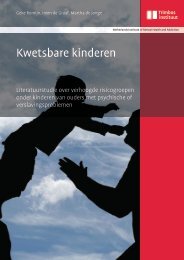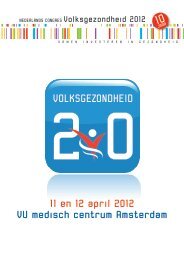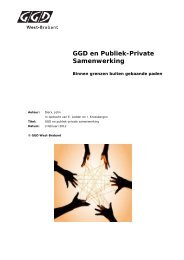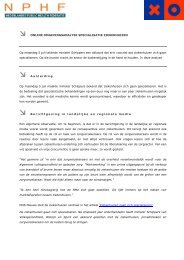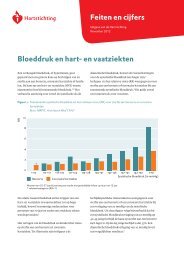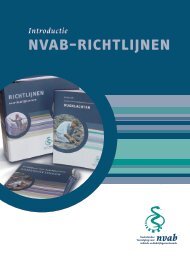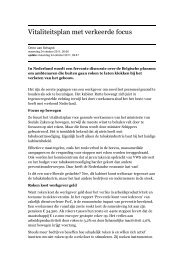Care onderzoekers in de landelijke pers - Nphf
Care onderzoekers in de landelijke pers - Nphf
Care onderzoekers in de landelijke pers - Nphf
You also want an ePaper? Increase the reach of your titles
YUMPU automatically turns print PDFs into web optimized ePapers that Google loves.
�<br />
bullet<strong>in</strong> van <strong>de</strong> netherlands school of primary care research<br />
◄ terUg Naar INHOUD<br />
26<br />
carré | jaargang 15 | nr 51 | maart 2010<br />
ess of occupational health <strong>in</strong>terventions. With respect<br />
to explor<strong>in</strong>g methodology, we asked three questions:<br />
1. how well are studies conducted, 2. how are changes<br />
<strong>in</strong> health-related productivity measured and valued,<br />
and 3. what is relevant when we want to estimate the<br />
cost of health-related productivity loss. To answer the<br />
first two questions, we conducted systematic reviews.<br />
To answer the third question, we conducted a modified<br />
Delphi study with 36 Dutch experts represent<strong>in</strong>g<br />
five different stakehol<strong>de</strong>r<br />
groups.<br />
SOMeONe whO The three ma<strong>in</strong> f<strong>in</strong>d<strong>in</strong>gs from<br />
COMeS TO wORk these three studies were as<br />
whiLe STiLL SiCk follows. First, <strong>in</strong> general, the<br />
methodological quality of<br />
economic evaluations conducted<br />
from a company’s <strong>pers</strong>pective was poor. The<br />
ma<strong>in</strong> shortcom<strong>in</strong>gs were related to how costs were<br />
measured and valued, how outcomes were measured<br />
and the test<strong>in</strong>g of key assumptions. Second, the methods<br />
used to measure and value changes <strong>in</strong> healthrelated<br />
productivity varied wi<strong>de</strong>ly between studies.<br />
Third, what is consi<strong>de</strong>red relevant when estimat<strong>in</strong>g<br />
costs of health-related productivity loss <strong>de</strong>pends on<br />
the type of productivity loss we are talk<strong>in</strong>g about. That<br />
is, is someone sick for a few days or weeks or are we<br />
talk<strong>in</strong>g about someone who comes to work while still<br />
sick. The take home message from these three studies<br />
was that specific gui<strong>de</strong>l<strong>in</strong>es for good practice are nee<strong>de</strong>d<br />
for the field of occupational health research, and<br />
future en<strong>de</strong>avours to <strong>de</strong>velop such gui<strong>de</strong>l<strong>in</strong>es should<br />
be conducted <strong>in</strong> collaboration with stakehol<strong>de</strong>rs.<br />
With regards to generat<strong>in</strong>g new evi<strong>de</strong>nce on the<br />
cost-effectiveness of occupational health <strong>in</strong>terventions,<br />
we conducted three economic evaluations us<strong>in</strong>g data<br />
collected alongsi<strong>de</strong> randomized controlled trials. The<br />
three trials <strong>in</strong>volved workers with subacute, non-specific<br />
low back pa<strong>in</strong>, workers with stress-related sick<br />
leave, and work<strong>in</strong>g mothers follow<strong>in</strong>g childbirth. In the<br />
first study <strong>in</strong>volv<strong>in</strong>g workers of subacute non-specific<br />
low back pa<strong>in</strong>, usual care by an occupational physician<br />
plus a gra<strong>de</strong>d activity treatment were compared to<br />
usual occupational physician care. We found that the<br />
gra<strong>de</strong>d activity program may potentially result <strong>in</strong> a<br />
net sav<strong>in</strong>g of €500 due to less sick leave compared to<br />
usual care, and we conclu<strong>de</strong>d that from a company’s<br />
<strong>pers</strong>pective, it may be worthwhile to implement<br />
gra<strong>de</strong>d activity.<br />
The second study <strong>in</strong>volved workers with stressrelated<br />
sick leave. One group received care by their<br />
general practitioners who were tra<strong>in</strong>ed <strong>in</strong> a m<strong>in</strong>imal<br />
<strong>in</strong>tervention strategy based on cop<strong>in</strong>g, problem<br />
solv<strong>in</strong>g and tak<strong>in</strong>g an active role <strong>in</strong> functional recovery<br />
rather than focus<strong>in</strong>g solely on symptom relief. The<br />
other group was treated by their (untra<strong>in</strong>ed) general<br />
practitioners as <strong>in</strong> usual practice. Our ma<strong>in</strong> f<strong>in</strong>d<strong>in</strong>g<br />
was that the m<strong>in</strong>imal <strong>in</strong>tervention for workers with<br />
stress-related sick leave was not cost-effective <strong>in</strong><br />
improv<strong>in</strong>g quality of life or reduc<strong>in</strong>g sick leave compared<br />
to usual care. A secondary f<strong>in</strong>d<strong>in</strong>g was that the<br />
m<strong>in</strong>imal <strong>in</strong>tervention appeared to be cost-effective for<br />
a sub-group of workers with uncomplicated stressrelated<br />
sick leave and no additional compla<strong>in</strong>ts of anxiety,<br />
<strong>de</strong>pression or physical symptoms. We conclu<strong>de</strong>d<br />
that there was no evi<strong>de</strong>nce to replace usual care with<br />
the m<strong>in</strong>imal <strong>in</strong>tervention strategy. However, further<br />
research should be conducted to confirm our f<strong>in</strong>d<strong>in</strong>gs<br />
about the subgroup.<br />
The third study <strong>in</strong>volved work<strong>in</strong>g mothers follow<strong>in</strong>g<br />
childbirth. One group received, <strong>in</strong> addition to the usual<br />
congratulatory phone calls, cards and visits, a telephone<br />
call from their supervisor 6-weeks after giv<strong>in</strong>g<br />
birth. Dur<strong>in</strong>g this phone call, the supervisor conducted<br />
a standardized <strong>in</strong>terview to i<strong>de</strong>ntify health problems<br />
that may <strong>in</strong>terfere with their ability to return-to-work<br />
after the end of their maternity leave. The aim was to<br />
ensure that women received timely support by occupational<br />
health services. The other group received the<br />
usual congratulatory phone calls, cards and visits. We<br />
found that the early case management by the supervisor<br />
was not effective and more expensive compared<br />
to usual practice. Therefore, we conclu<strong>de</strong>d that there<br />
was no evi<strong>de</strong>nce to replace usual practice.<br />
�




